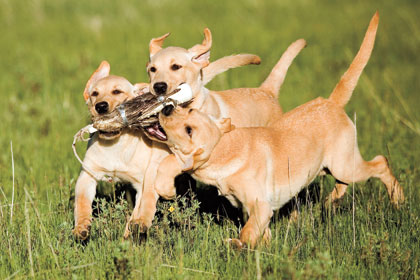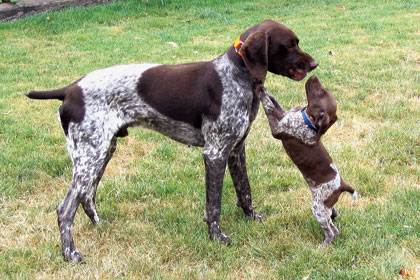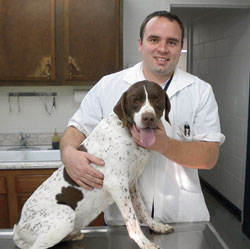Humans aren't the only ones at risk. Be prepared to protect your dog!
By Brad Fitzpatrick
When greyhounds at a Florida racetrack began falling ill in 2004 veterinarians quickly diagnosed the disease as an outbreak of canine influenza. First identified over 40 years ago, canine influenza is a virus that acts very similarly to the human flu. Soon greyhounds at other racetracks throughout the South began falling ill, some of which suffered major complications as a result of the outbreak.
 These Labrador pups are the picture of vibrant health. But owners should watch for signs of lethargy, runny nose or cough and immediately have any dog exhibiting such symptoms examined by a veterinarian. |
Veterinarians quickly realized that this particular strain of canine influenza, known as a H3N8, was not the common strain of the flu. This particular strain had originally been found in horses but had mutated to infect dogs as well, similar to the H1N1 flu in humans, which originated in pigs and later mutated, allowing the virus to be spread from person to person.
Since 2004, canine influenza H3N8 has spread throughout much of the country. Currently 20 states have reported cases of the flu and it will likely spread nationwide before the outbreak ends. Although not commonly fatal to dogs, canine influenza should be a concern to anyone who operates kennels, breeding facilities or travels with hunting dogs.
All gun dog owners need to be aware of the danger canine flu represents to their hunting dogs and should take steps to avoid contact with the disease. Breeders need to take special steps to avoid bringing canine flu into their kennel facilities since females and their pups are at higher risk for complications and death than most dogs.
"The disease spreads just like human flu," says Mark Hayes, DVM, of Mount Orab Veterinary Clinic. Hayes has to be especially aware of highly contagious canine diseases such as H3N8 because of the number of dogs that are in his facility at one time.
Similarly, breeders and gun dog owners that have their dogs in contact with other dogs need to be particularly aware of how the disease spreads and how to avoid it. Even though it is rarely fatal canine influenza can still cause respiratory distress, weight loss and can spoil hunting season for you and your hunting companion.
"The canine flu virus can live almost anywhere in a dog's environment. Kennels, dog boxes, bedding, water and food dishes and even collars can hold the virus and dogs that share any of these things will be exposed to everything that the other dog comes into contact with," Dr. Hayes says. On most days his clinic will see between 15 and 50 dogs, any one of which could be carrying the flu.
"We have to be sure that everything is completely sterile. Dog owners should do the same thing, cleaning water and food dishes with soap, sterilizing kennel facilities and dog boxes with soap or a mild disinfectant." Hayes adds that dog owners should do their best to wash their hands before and after contacting their dog and should be especially aware of touching other dogs.
 Greetings among dogs usually involve muzzle to muzzle contact. Avoid exposing your dogs to others and the risks of canine flu will be reduced. |
"If someone in the clinic pets a dog in the waiting room and then touches their own dog they may be exposing their own dog to disease. This type of contact does not spread the disease as easily as nose-to-nose contact between dogs but by petting dogs without washing their hands owners can still transmit the disease among the dogs in their kennel."
The same is true when hunting. Almost every shooting preserve has dogs in kennels or resting in the clubhouse. By petting those dogs and then handling their own, gun dog owners are unintentionally exposing their own dogs to potential diseases.
"Canine influenza is of special concern to dog owners who travel with their dog," Hayes adds. Many dogs stay in one location all of the time. They rarely come into contact with other dogs and therefore they don't face a high risk of exposure to this disease. But gun dog owners frequently travel with their dogs, placing them at much higher risk than average house dogs. Hunters need to be very aware of exposing their dogs to this disease.
"Even if your home state has a low rate of canine influenza be aware that other areas that you travel into may have several cases of the disease. Even if outbreaks have not been reported in the area where you are hunting it is still possible that canine influenza exists so it pays dividends to take precautions anytime you and your dog are traveling."
Elevated risk
Breeders and kennel operators are at much higher risk for canine flu outbreaks because of the number of dogs traveling in and out of their facility. When possible avoid having owners bring their dogs into your kennel area unless it is necessary. Training facilities should keep new dogs separated from others until the dogs have been on site at least a week. If there are no signs of infection dogs may be introduced to others, although even after a week there is still a slight risk that the new dog carries the virus.
"Dog owners need to watch for the signs and symptoms of canine influenza," Hayes says. He encourages owners to pay close attention to their dog's behavior and periodically check for signs of infection.
"Canine flu is a respiratory disease. Once the dog has a full blown case of the disease they will cough, sneeze, wheeze, choke and have difficulty breathing." The key to protecting your dogs, however, is noticing the very first signs of the disease.
 Dr. Mark Hayes finishes an examination of a German shorthair. Dogs should be examined by a veterinarian immediately if they show signs of listlessness, fatigue, loss of appetite or coughing and nasal discharge. |
"Be on the lookout for a dog with a runny nose, listless eyes or a sudden decrease in energy," Hayes says. "Many owners have a tendency to take a wait-and-see attitude when their dog is showing these primary signs of being ill. In the case of canine influenza, however, waiting until the disease has taken full effect increases the chances of complicatio
ns and death."
Dogs that show the classic signs of canine influenza, namely lethargy, a runny nose and a cough, should be taken to the vet immediately and should not be exposed to other dogs in the kennel. The virus has the potential to survive on surface materials so a sick dog's bedding should be removed and its kennel, food and water bowls and dog box should be thoroughly disinfected.
Dogs with increased susceptibility to disease, namely older dogs, pregnant and nursing females and their pups should be isolated from other dogs when possible and extra care should be taken to reduce the chances that these at-risk dogs will be exposed to the disease.
Viral communication
Dogs by their very nature are likely to spread the virus when they greet other canines nose-to-nose. This instinctive characteristic means that dogs are at the highest risk when they are in contact with other dogs. Take care not to hunt with unfamiliar dogs and avoid places where your hunting dog is likely to have contact with several other dogs.
"When a dog is taken for a walk, turned loose in a park or greets dogs through the door of a shooting preserve kennel they are being exposed to every infective agent that those dogs carry. Gun dog owners need to minimize these meetings."
Canine influenza is likely to keep spreading across the country throughout 2010. The good news is that as veterinarians become more aware of the disease and better at diagnosing it there is a greater chance that the disease will be properly treated. A recently approved vaccine is now available from Intervet/Schering Plough Animal Health Corporation. The vaccine does not always prevent dogs from contracting the disease but it shortens the length of infection and will reduce the potential for long-term complications.
Dog owners who travel a great deal should contact their veterinarian and discuss whether or not having their dog vaccinated is a viable option. It is the responsibility of gun dog owners everywhere to do their part to protect the dogs in their kennel and reduce the spread of H3N8.
Hunters who travel with their dogs need to understand the potential risks that canine influenza poses to their four-legged friends and should try their best to avoid spreading this potentially deadly disease. Likewise, trainers, kennel operators and breeders should be especially vigilant and should take steps to reduce infection in their facilities.
By being aware of the facts, responsible gun dog owners can minimize the risk to their dogs and reduce the chances that their dog will spread the disease. Early detection is a key to successful treatment so pay close attention to your dogs and avoid exposing them to this potentially deadly disease.






